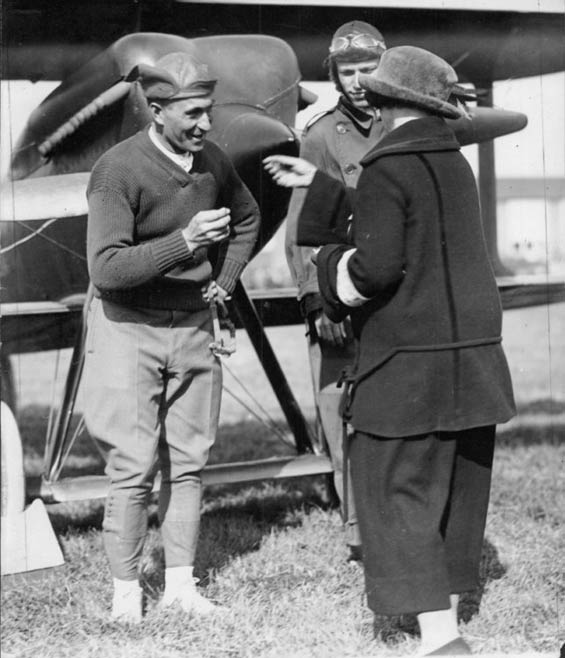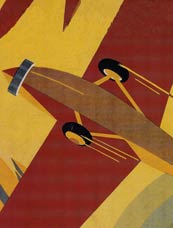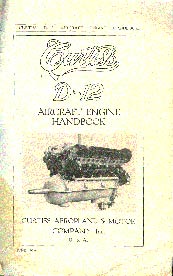Russell Maughan, 1924
(Source: NASM)
 |
Russell Maughan is one of the more prestigious military
pilots of the Davis-Monthan Airfield Register. He visited
Tucson solo on March 25, 1929 flying a Consolidated PT-1,
26-314. He was born March 8, 1893 and died April 21, 1958.
Five years before his Tucson visit, Maughan was credited with making the
first ever east-west U.S. transcontinental flight during
"daylight" hours. On Monday June 23, 1924, in a
race with the sun, he flew a Curtiss PW8 Pursuit airplane
the 2,645 miles between Mitchel Field, New York (departing
at 3:00AM EST/4:00AM DST) and Crissy Field, San Francisco
(arriving at 9:48PM PST) in 21 hours 48 minutes. His airplane
was powered by a used, 685-pound Curtiss D-12 engine (right
sidebar), which
had run about 140 hours by the end of his record flight.
His total elapsed time included 3 hours and 28 minutes consumed
at five rest and refueling stops. The actual flying time
was 18 hours 20 minutes, making his average ground speed
in excess of 156 MPH.
On the morning of his flight, the weather was deemed good
all the way across the country. Maughan arose shortly before
departure and ate a breakfast of scrambled eggs, bacon and
toast, preceded by a cantaloupe he found in the refrigerator
at the Officer's Club. Below, courtesy of the Library of Congress (LOC), two photographs of Maughn after his cross-country record. The first is of him and Major General Mason Patrick (left), then Chief of the Air Service.
Mason Patrick (L) and Russell Maughan, July 8, 1924 (Source: LOC)
 |
Below, a crisp portrait of an Army record flyer. These two photographs were taken at the same location, probably within minutes of each other. Notice the open window on this July day before central air conditioning was common.
Russell Maughan, July 8, 1924 (Source: LOC)
 |
Below, another congratulatory photo. The caption for this LOC image reads, "WEEKS AND PATRICK CONGRATULATE MAUGHAN—The coast-to-coast by daylight flier (right), as he looked when welcomed by Secretary of War Weeks (center) and Maj. Gen. Mason Patrick (left), chief of the army air service. July 8, 1924 – LOC image LC-DIG-npcc-25917."
Patrick, Weeks, Maughan, July 8,1924 (Source: LOC via Woodling)
 |
It wasn't his first attempt to fly that route in that time
frame. He had made two earlier attempts the previous year
on July 10 and July 19. Both these attempts were terminated
because of mechanical problems (a plugged fuel line on the
10th and an oil leak on the 19th).
Below, courtesy of Andy Heins, is a photo of Maughan, date and location unknown. The airplane is also not identified, although it looks similar to the Curtiss cockpit design.
Russell Maughan, Date, Location & Aircraft Unidientified (Source: Heins)
 |
Below, Maughan appears at left. The airplane behind him is a Curtiss aircraft, but it is not clear if it is the one he flew coast-to-coast, or if the photograph was taken before or after his flight. The woman is not identified and the other pilot looks a lot like fellow Register pilot Lester Maitland.
Russell Maughan (L), Date & Location Unknown (Source: Heins)
 |
Upon completion of his 1924 flight he handed over a copy
of the New York Times of June 22 that he had carried
with him to San Francisco Mayor James Rolph, Jr. This had
to be the first time an east coast newspaper was delivered
so promptly to the west coast. He received high accolades
for this flight from President Coolidge, Secretary of War
Weeks and Chief of the Air Force Mason Patrick. Other images of
Maughan and his Curtiss airplane are available at the Klein Archive on
this site. Below, a photograph of Maughan from the Library of Congress (LOC), via Bob Woodling (cited, right sidebar). The airplane is the Curtiss Model 33 XPW-8 (23-1201). It was built on speculation by Curtiss and sold to the Army in 1923. The photo was taken in January 1923 before it was acquired by the Army.
Maughan used it on his first two attempts at the daylight coast-to-coast flight. Maughan's record flight was set in the fourth production PW-8 (24-204).
Russell Maughan in Curtiss Pursuit Aircraft, Date & Location Unknown (Source: LOC via Woodling)
 |
BG Sparkplug Advertisment, July 1924
 |
At left, a contemporary advertisement for BG sparkplugs,
the type used during the Dawn to Dusk flight, and the type
used by government contractors and engine builders. Please direct your browser to the link for a brief history of the BG company.
This interesting
page from the Oxnard
Daily Courier announces,
center, Maughan's departure time from New York and a status
report of his location (Cheyenne, WY). Note also on this
page the bumper crop of fine apricots that early summer,
and, down near the bottom right of the page, the greeting
of the World
Cruisers in India.
Besides his
cross-country flight, Russell Maughan earlier finished first
in the 1922 Pulitzer Air Race, flying a Curtiss R-6. Later,
Billy Mitchell used the same plane to set a speed record
of 222.97 MPH. A Wikipedia biography
is available at the link, with the usual cautions. Below, courtesy of the Library of Congress, is a photograph of Maughan and the R-6 from 1922.
Russell Maughan and Curtiss R-6 Racer, 1922 (Source: LOC)
 |
Below, a schematic of the R-6 racer from the Summer, 1970 issue of the AAHS Journal.
Curtiss R-6 Racer, Schematic Diagram (Source AAHS Journal via Woodling)
 |
Below, a U.S. Postal Service cachet commemorating Maughan's transcontinental filght.
U.S. Postal Service Cachet, June 23, 1974 (Source: Woodling)
 |
---o0o---
Dossier 2.2.130
THIS PAGE UPLOADED: 10/13/07 REVISED: 10/15/07, 08/22/11, 09/09/11, 01/13/12, 01/16/12, 04/02/12
|














